I built a solar-powered bike. It works, but not quite as well as I’d hoped.
I started with a 2008 Currie “E-Zip Mountain Trailz” (sic; ugh) electric bike, which works pretty well.
That is powered by a pair of 12v 10AH SLA batteries, in series for 24 volts. I’ve always been afraid to ride for long distances for fear I’d run out of power before getting home. (The thing weighs 70 pounds, and I’m no athlete, so it’s painful to go up hills without power.)
I’d been thinking of putting solar panels on it to charge the batteries while I ride. I didn’t have any appropriately-sized panels around, so I didn’t do it until this summer, when I decided to try using a bike trailer to hold the panels.
The trailer solves the problem of the panels being shaded by my body when I ride, and also avoids problems with the weight of the panel hardware messing up the balance of the bike.
I have some 20 year old Siemens SM55 modules, rated at 55 watts (new, when pointed at the sun). These things are huge and heavy – 51 x 12 inches, and 12 pounds each (1300 x 330 mm, 5.5 kg). And since the eBike runs on 24 volts, I’d need 2 panels in series to charge the battery (at least without a DC-DC boost converter). That’s 24 pounds, not counting mounting hardware.
But, hey, with a trailer, who cares how much it weighs, right? And 110 watts is a lot of power – likely enough to completely power the bike while riding (on average, on a sunny day).
So I got a used bike trailer; $50 on Craigslist:
Then I used a couple of pieces of lumber to attach two panels together (at the ends), and mounted more lumber on the sides for mounting on the trailer. I cut slots to fit the trailer poles, and attached the panels to the trailer using standoffs and cable ties:
I was going to get a 24v charge controller to avoid putting too much voltage into the batteries, but I haven’t gotten around to that – I just wired the output of the panels (in series) parallel with the 24V battery; good enough for now.
So, how does it work?
It works. Mostly, sort of. As long as I’m riding in full sunlight I can go indefinitely if the road is level or not too steep.
I tried a test run riding to work – about 12 miles – on a sunny day.
I weigh nearly 220 pounds, the bike is 70 pounds, and the trailer with the panels is something like another 50 pounds. So the whole setup is maybe 350 pounds. That’s too much for the motor to pull up a steep hill without a lot of help from me.
I got to work OK and not too tired, in about 90 minutes (about 8.2 mph average – not at all impressive by road bicyclist standards). I did have to work my way up hills.
At work I got delayed and ended up going home close to dusk. I started out riding in the shade. Halfway home, I had a dead, dead battery and about 7 miles still to go. And 350 pounds to drag up each hill. After mighty struggles, I gave up and called for a ride home.
A week or so later, I tried the same trip on a light steel street bicycle (about 20 pounds, with narrow smooth tires and no suspension – in other words, efficient).
I got to work again in about the same time, only slightly more tired than with the electric bike. With the vastly lighter and more efficient bike, going up hills with that was no harder than with the solar bike (with the motor helping). And I was able to get home with no problem.
In the end, a simple street bike turned out to be just as fast, not much more effort to ride, and way more practical – it even works in the shade.
But it was fun to try.
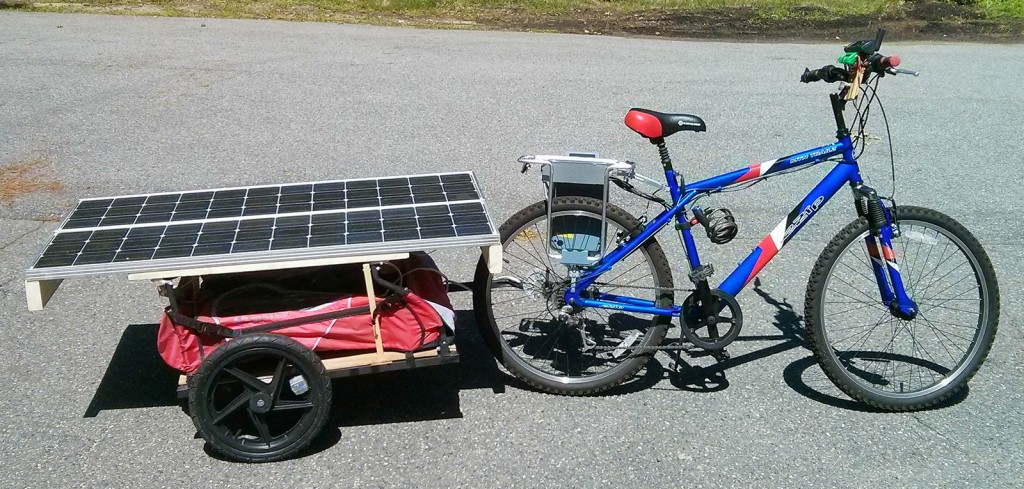
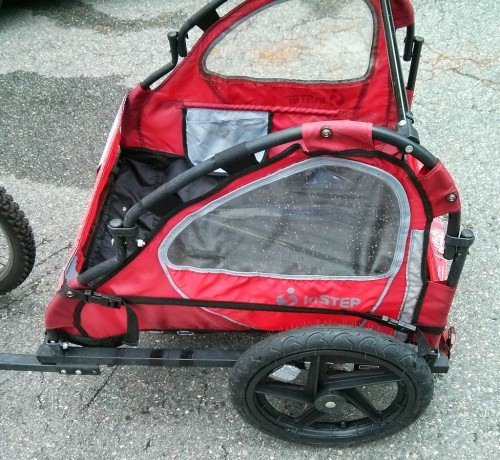
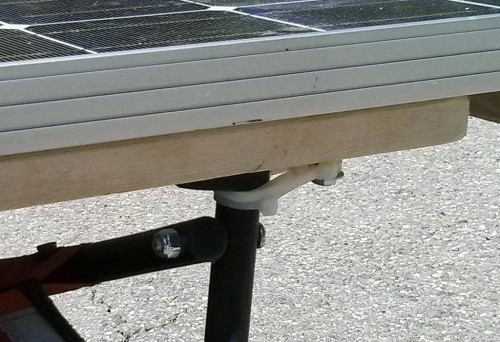
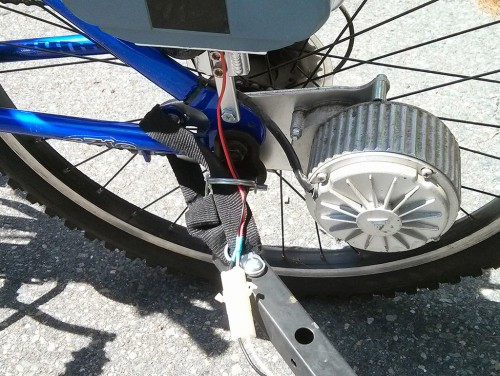
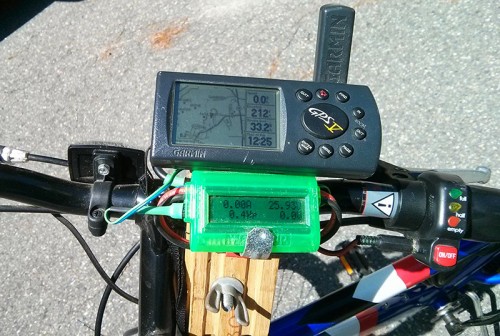
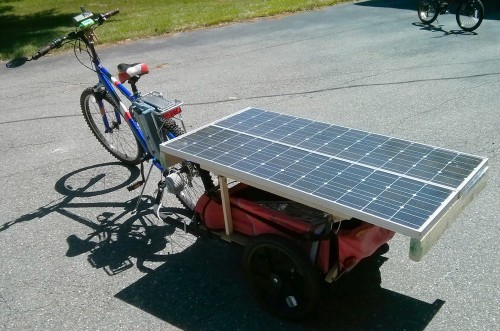
#1 by Max on 2014 July 12 - 14:12
Quote
Hi
I really like your experiment. I found your website from craglist adv .
I would try Electric bike kit with engine 1000w . I ‘d add also two – three car battery for 12 V + controller for each solar panel. I’d also suggest to add solar panel on the left and right side. All the additional will add wight but the buttery should give you extra power for go home over dust. I still think about buying small electric bike with 30 miles range on one charge with no solar panel. I think about adding solar charging station at home for the electric bike with solar panels and car batteries + controller. I considering to by 20 inch Prodeco V3 Mariner Seven 8 Speed Folding Electric Bicycle, Pure White Gloss, 20-Inch/One Size . Let me know your thoughts about electric bikes.
#2 by Dave on 2014 July 14 - 03:21
Quote
Hi, Max.
If I was going to do more with it, I’d:
1 – Swap out the SLA batteries for LiFePo4 batteries.They’ll have something like 3x the capacity and 1/3 the weight. That’ll make a big difference.
2 – As you suggested, use 2 packs of batteries instead of 1. The bike is setup with 2 battery racks, one on each side. Right now only one side is in use. I’d make my own packs out of worn-out SLA packs and replace the cells.
3 – Again as you suggested, replace the motor with a more powerful one. There are threads online by e-bike enthusiasts who have done this; some of them sell kits. Another idea – if I were more mechanically inclined – would be to attach the motor (even the same one) to the pedal chain instead of the back wheel hub. Then you could use the bike’s normal gearing to make it easier to get up hills (and also to go faster when it’s flat).
4 – Install a proper solar charge controller and charging circuit (not hard).
5 – Either beef up the suspension on the trailer, or make/get a tougher one. Right now the only suspension is the air in the tires; every bump whacks the trailer pretty hard (tho it’s held up fine so far).
I think it has plenty of panel area already (probably more than it needs) and adding side panels would make it wider, and less safe to ride on the side of the road. So I wouldn’t do that.
But I have too many projects (as is clear from the rest of this blog…and I’ve got other stuff going on for work, and that I haven’t posted here yet). And my son complains that the bike is in the way of the lawnmower.
So it stays on Craigslist till it sells. Hey, if you’re in Boston, make me an offer! 🙂